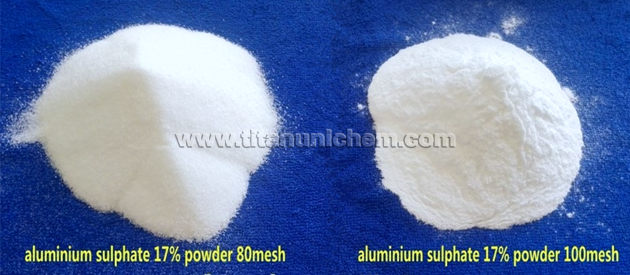Al2(SO4)3, CAS no.10043-01-3;
White or grey crystal solid;
For drinking water treatment;
For paper making and leather.
| Chemical Identification |
|
Common Name: |
Aluminum Sulfate (Aluminium Sulphate) |
|
|
Aluminium Sulfate; Non-Ferric Aluminium Sulphate; Non-Iron Aluminum Sulphate; |
|
CAS No.: |
10043-01-3 |
|
EINECS No.: |
233-135-0 |
|
Appearance: |
White or grey crystal solid or liquid. |
|
Density: |
2.71 |
|
Melting Point: |
770°C |
|
Boiling Point: |
330°C at 760 mmHg |
|
Stability: |
Stable under normal temperatures and pressures. |
|
Molecular Formula: |
Al2(SO4)3 |
|
Molecular Weight: |
342.15 |
|
|

|
| Product Information |
Specifications:
Specifications of Aluminum Sulfate
|
Product name: Aluminum Sulfate Manufacturer: Ningbo Titan Unichem Co., Ltd. |
||
|
TEST ITEMS |
SPECIFICATIONS |
|
|
Low Iron |
Iron Free |
|
|
Al2O3 |
15.8-16% |
17% min |
|
Ferrous |
0.3-0.5% |
0.005% max |
|
Water Insoluble |
0.1% max |
0.1% max |
|
pH (1% aqueous sol.) |
3.0 min |
3.0 min |
|
Arsenic (As) |
/ |
0.0005% max |
|
Heavy metal (Pb) |
/ |
0.002% max |
Specifications of Liquid aluminum sulfate
|
Product name: Liquid aluminum sulfate Manufacturer: Ningbo Titan Unichem Co., Ltd. |
|
|
TEST ITEMS |
SPECIFICATIONS |
|
Al2O3 |
7.8% min |
|
0.25% max |
|
|
pH Value |
3.0 min |
|
Water insoluble |
0.1% max |
Pictures:

Appearance of aluminum sulfate from TITAN UNICHEM.

Appearance of aluminum sulfate from TITAN UNICHEM.

Appearance of aluminum sulfate from TITAN UNICHEM.

Appearance of aluminum sulfate from TITAN UNICHEM.

Appearance of aluminum sulfate from TITAN UNICHEM.
Packaging:
-
Packed in 25Kg/50Kg PP-PE woven bag, 1000kg jumbo bag;
-
20-25MT can be loaded per 20ft FCL container.
-
Or package as per customer's request.
Delivery Lead Time:
-
Prompt shipment within 2 weeks.
Storage & Handling:
-
Store in a cool, dry and well-ventilated place.
-
Keep away from moisture, heat and fire.
-
Keep away from oxidizing materials.
-
Store in a tightly closed container.
Safety Information:
|
RIDADR: |
UN 1760/3077 |
|
HS Code: |
2833220000 |
|
Risk Statements: |
R36/37/38;R51/53 |
|
Safety Statements: |
S26-S29-S37/39-S61 |
|
Hazard Codes: |
Xi: Irritant |
| Application |
Descriptions:
-
Aluminium sulphate is white or grey crystalline flake, particle or powder, odorless.
-
Aluminium sulphate will be to cake after moisture absorption when laid in air for a long time.
-
Aluminium sulphate is soluble in water easily; the pH of water solution can be less than two, which can make it capable of burning human skin and corroding metal.
-
Aluminium sulphate is hygroscopic, which means it has the ability to absorb and hold water molecules from the surrounding atmosphere.
-
Industrial aluminum sulfate raw material contains Fe2+ iron, its a little green because of Fe2+, yellow when Fe2+ is oxided to Fe3+.
Uses:
Water Treatment:
-
Aluminium Sulphate is used for purification of drinking water and wastewater treatment by settling of impurities by means of precipitation and flocculation. When added to water, Aluminium sulphate causes microscopic impurities to clump together into larger and larger particles. These clumps of impurities will then settle to the bottom of the container or at least get large enough to filter them out of the water. This makes the water safer to drink. On the same principle, aluminum sulfate is also sometimes used in swimming pools to decrease the cloudiness of the water.
Dyeing Fabrics:
-
For dyeing and printing on cloth, when dissolved in a large amount of water that has a neutral or slightly alkaline pH, Aluminium sulphate produces a gooey substance, aluminum hydroxide. The gooey substance helps dyes stick to the cloth fibers by making the dye water insoluble. The role of aluminum sulfate is as a dye fixer, it combines with the molecular structure of the dye and the fabric so the dye won't run out when the fabric gets wet.
Paper Making:
-
In making paper industry, Aluminum sulfate helps to size of the paper. In this process, aluminum sulfate was combined with rosin soap to change the absorbency of the paper. This changes the ink-absorbing properties of the paper.
Gardening:
-
Aluminum sulfate is extremely acidic, sometimes it's added to very alkaline soils to balance the pH for plants. When the aluminum sulfate comes into contact with water, it forms aluminum hydroxide and a much diluted sulfuric acid solution, which alters the soil acidity.
Leather Tanning:
-
Many tanners use a mixture of aluminum sulfate, sodium carbonate, sodium chloride and flour which is made into a paste and applied to the dried skins. The paste is allowed to sit on the skin for at least 24 hours before it is scraped off and reapplied. This is repeated several times. The sulfate acts as a preservative and prevents the skin from decaying
| User name | Member Level | Quantity | Specification | Purchase Date |
|---|


















